
This page introduces my experiments with impromptu and easy-to-build-from-scratch greenhouses.
(Newer information will be added as time permits).
(Skip introduction-- Click to see Roll Top Garden Cover)
An easily built convertible dome greenhouse!
Compost reactor or bio reactor page.
We neglected our vegetable garden about 30 years. In order to focus on income paying jobs (during the boom years). As of 2009 job prospects are diminishing. My earlier interests in self-sufficient living styles has increased a lot. Boosting organic soil fertility will take more years. This is essentially hard labor, which can need strong inspiration. Many years of creative concrete promotional efforts, convinced me that path is not actually profitable monetarily. No matter, i am thankful for the experience and can now move onward to more humble pursuits. I worked hard at rebuilding green-manure-compost piles, and bed drainage, in 2009.

Above: Cold-Frame during December 2009, frozen snow-scape outside- With barely thawed ground inside. Later in the winter, a solid crust of frost hardened the ground. Low winter sun angle and deeper snow reduced heating. Below-- After plastic sheet removal, March 2010, weather is barely above freezing, the Kale seems OK. (Actually 2 different garden beds, with same winter treatment).
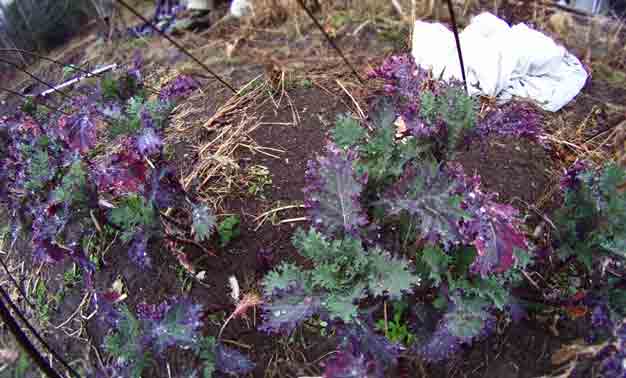
The2009 summer growing season in Maine was very rainy, damp and overcast, with infrequent days of sun. It appeared that 'hot houses', 'hoop houses' and protection from long periods of damp days, did help many gardeners avoid the dreaded blight. With new determination, i improved my raised beds, added new compost and also some fine, local sand, (with lots of wheel barrow work).
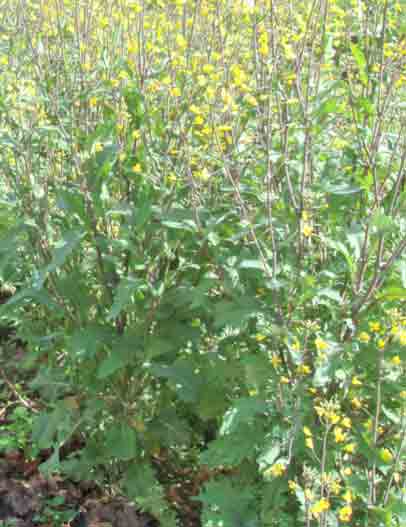
Above, same kale in flower, during May. While the leaves are smaller in this second summer season, these plants have been regularly harvested for the larger leaves and for the flowerets. Yum! One of my favorite, nutritious, organic crops. I'm shifting over to fully green-weed-compost and teas of the same, once rains desist. After so many years devoted to other work occupations. Besides, the honey bees and bumble bees love these blooms. (Please recall, all of these pictures are purposefully blurred to assist 'dial up' and mobile connections).
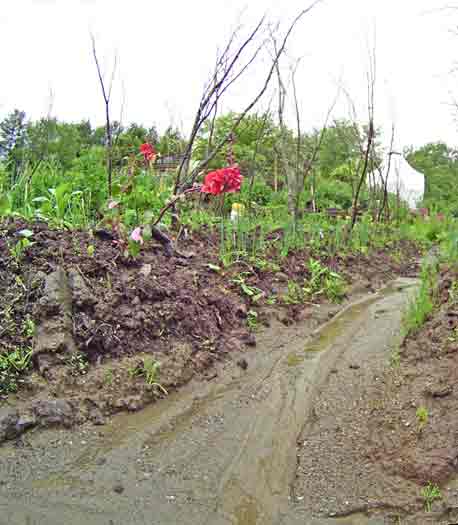
Long term healthy soils, complete with organic eco systems, also greatly forestalls the effects of bad seasons-- 2009 was surely a wake up call-- Given the destruction of economies by financiers who use elaborate investment instruments which amount to little more than illusive gambling and Ponzi schemes. (Covered up with many layers misleading terms, encouraged by governments. Well, until actual assets are called for and are then found lacking. This is becoming more apparent, regardless of scripted media lies. This combined with war mongering by the hoped for elected leaders of change, means we are momentarily doomed by incompetents in office. Too much financing goes into destructive war industries. Old Wisdom: "It is easier to make nothing out of something. It is hard to make something out of nothing." Also, it requires effort to maintain good things.)

My 34 year old grape trellis frame works of rebar are still standing and without coatings other than natural rust. Just to behind our pup, can be seen a crude stick jammed under circular top of this grape arbor. This arbor had a huge ice slide fall on it a few years ago, which snapped one of the rebar supports. Over the years, #3 rebar rod, (3/8ths inch or nearly a centimeter in diameter), has proved to be the best priced framing and very durable in the garden frameworks. By comparison, metal tubing presents more surface area for corrosion. Plastic risks buying PVC which is a vial polluter of the planet. (Though other plastics might one day provide better options-- Don't holdd your breath for that one). I should also describe my thinking about arbor construction, but separately, someday. Here again, follow some new #3 rebar arches made from half length rods, (each about 10ft long). These are very simple to install, all by one's very own self.
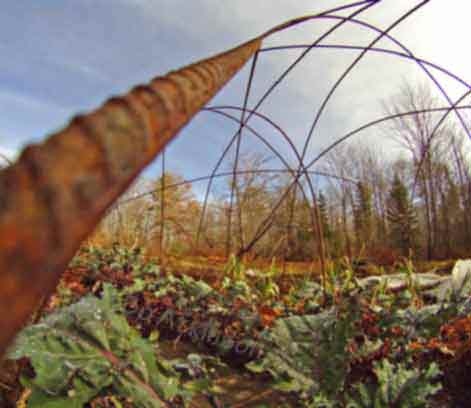
My trusty kale was slow growing during the foggy and rainy summer of '09. I decided to cover it over with my rebar arches and cheap plastic sheet. This also promotes winter greens, but next year my soil improvements should give a much better yield. I say this to encourage people to persist, even though beginnings are often difficult to endure. Take courage. Find some land, in a region with reasonable rain fall. Start gardening. Or associate with small farmers and gardeners.
A cheap greenhouse frame which opens up like an eyelid. Click here
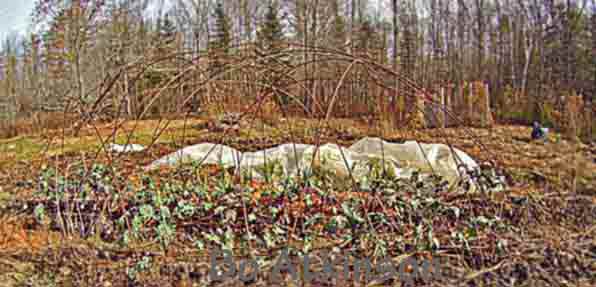
This style of 'crawl-through cold-frame' easily adapts to most any garden layout, even after the fact. Even as an after thought! One can delay it until the last minute, (because summers have so many other demands). If the season turns too wet as 09 did, just roll yourself some #3 rebar. With a swirling flourish, spread out a sheet of plastic, for covering. It is always good, health-promoting exercise, besides.
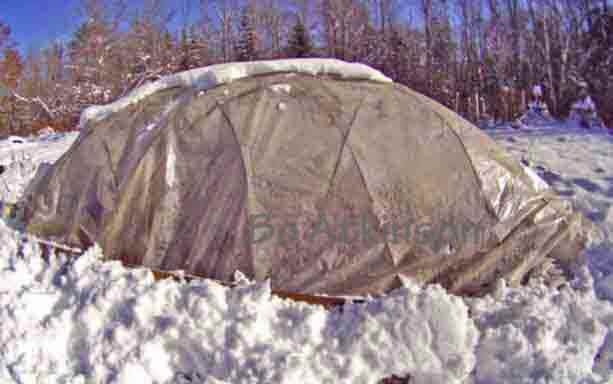
Snow or dirt generally seal the plastic edges against the ground. Snow is easy to brush off the south face. Let not a cold winter depress oneself. Crawl into your creative-shelter and reconnect with earthen energies. Frost is reduced a great deal, even by one thin plastic layer. Empower self, escape the big-box depression of life energies.
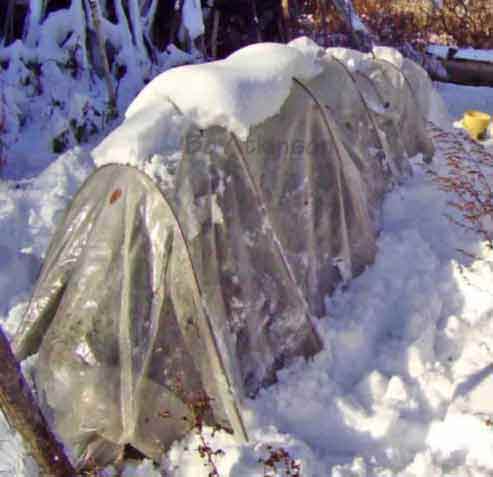
These are crawl-through houses. Also called 'hoop houses', but i prefer the name arch-houses. My '09 kale was not even half as good as in better years, of the past, but it has been worth the low cost investment in steel and plastic. Ground freezes less than expected inside, allowing one to continue digging leaks and potatoes.
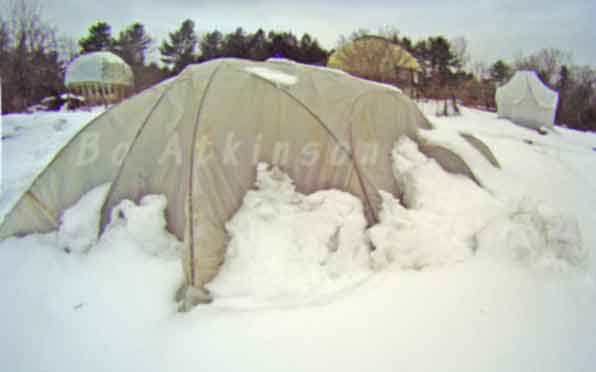
Four 'Greenhouse' Types Impromptu & Complex-- Seen in the foreground and the background of picture above.
Left top: wavy dome -- Foreground- rebar cold frame --Top middle- attic garden -- Top right- planar curved
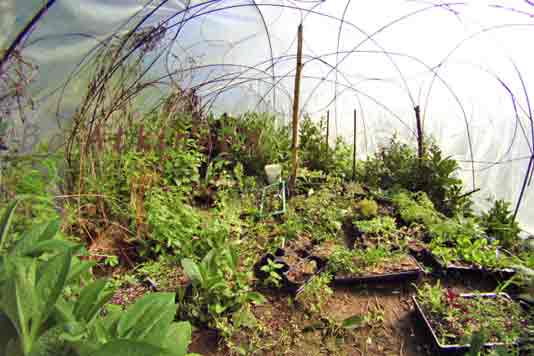
Above is yet another variation of plastic sheet over steel rod. It's a much older frame experiment. The season was early spring. Originally it was a study of using only quarter-inch-thick steel rings. Later some 3/8" rebar (number 3 rebar) arches were added, because it was too minimalist. My experiments always included some study of applied-minimization in search for potential efficiency. How might the experimental design work in a more advanced and a civilized world? The fact is, that domes can be made with simple lengths of rebar. Below shows March wind effects, as leaves in the woods have not budded yet. Very simple covering with 20X20 ft of 6mil PE plastic sheet. Held down by stones and logs. Note that plain, out of the box plastic sheeting is used without re-seaming, without concern over loose folds. This page focuses on rough and ready cost savings.
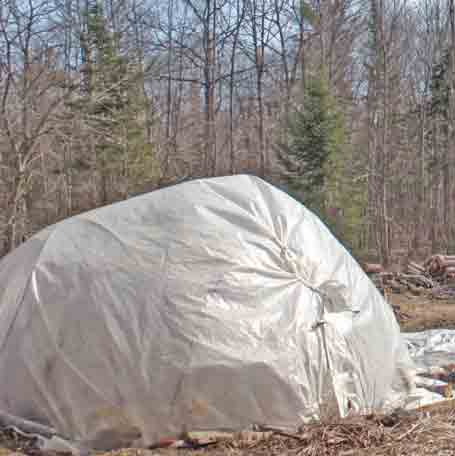
Even in the winter, projects can proceed. Keep's one active and with ice and snow covering your garden space. Simply use a short piece of rebar as an 'ice-pick' like chisel. Pound your way through the frozen ground. (This should not be so difficult in an established growing soil). Then insert a series of arched rebar lengths. (I'll add some demo pictures on rebar bending, though intuition should go a long way for you). Call them 'hoops' if you prefer, except that the word hoop is defined as full-circle rings. Cover with a sheet to accelerate the spring thaw for a few garden beds. Get an early start this spring, as temperate climates offer short growing seasons. There is no time to loose. Too many warm climates are draught ridden, be thankful in wet, cool climates. Plan for your well being, take greenhouse action.
Upgrading this frame: New Eyelid Greenhouse made easy and it is low cost competitive, with good growing advantages.
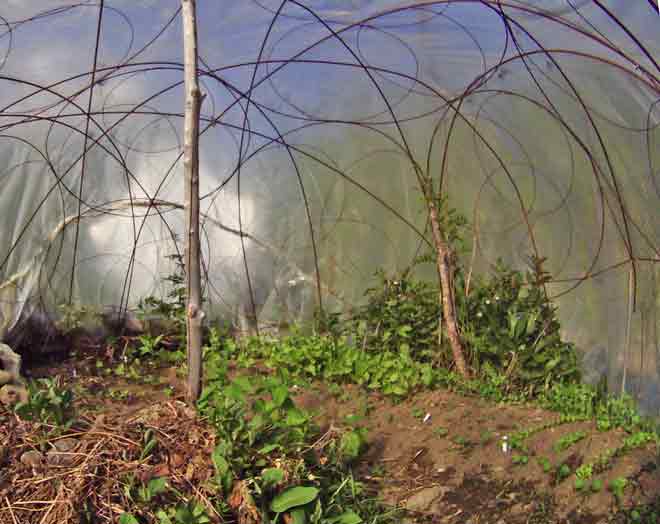
This older, rebar, 'wigwam' frame might imply ringed purlins. It is shown above with a bean crop germination. Below mini bean crop progress in July.
Here is the web page showing how to 'close-the-lid' for bad spells of weather! Keep ahead of the curve! Do so on an average person's budget!
Next is my August 2011 update of my slowly materializing, Roll top Greenhouse, (after Installing some PE plastic sheet).
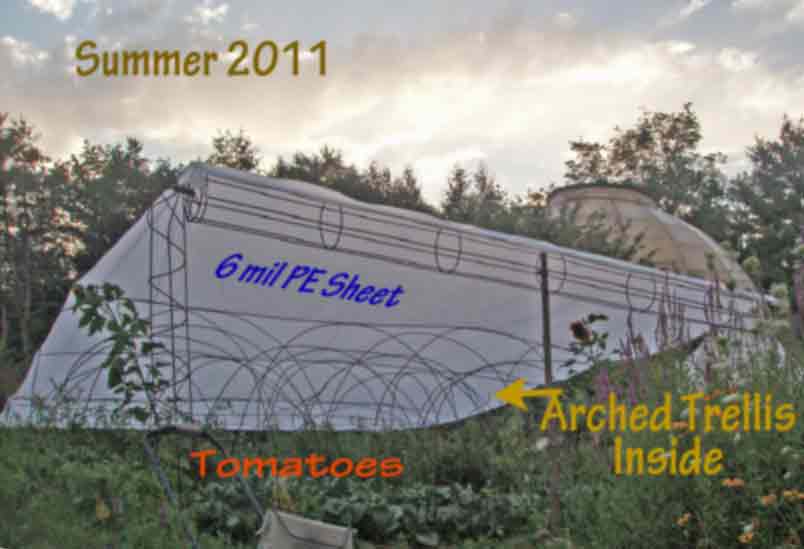
Side view is next. This roll top greenhouse was originally devised to deter the dreaded late blight which has been suffered since 2009. Evidence that late-blight was avoided inside greenhouses, has been provided by many people. Therefore the experiment was tried.
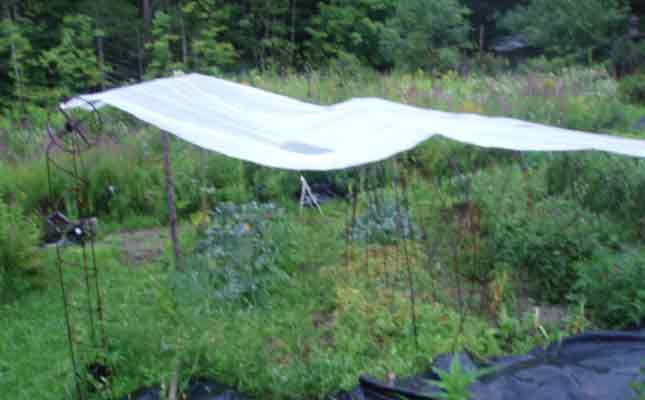
First rain puddle, after installation is in foreground. This was corrected with a little adjustment.
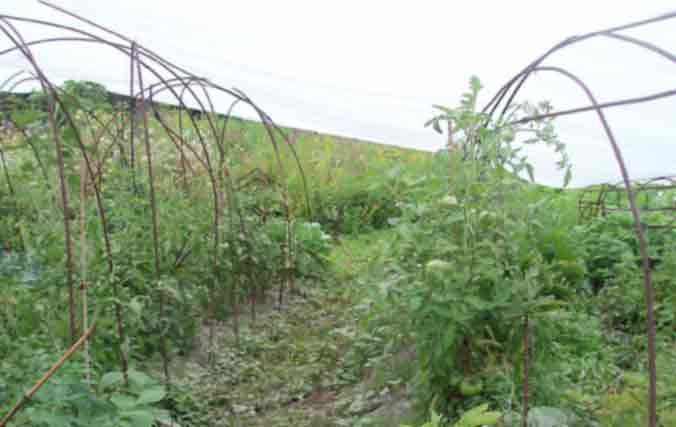
I also applied a light dusting of Portland Type I cement to soil to enhance drying effects. Next are earlier conceptualization renderings.
Building and using the above experimental system seemed tiresome. Yet three rainy and humid summers in a row suggests that some remedies are needed for worsening climatic conditions. If one wants a little backup for worsening economic and general world conditions.
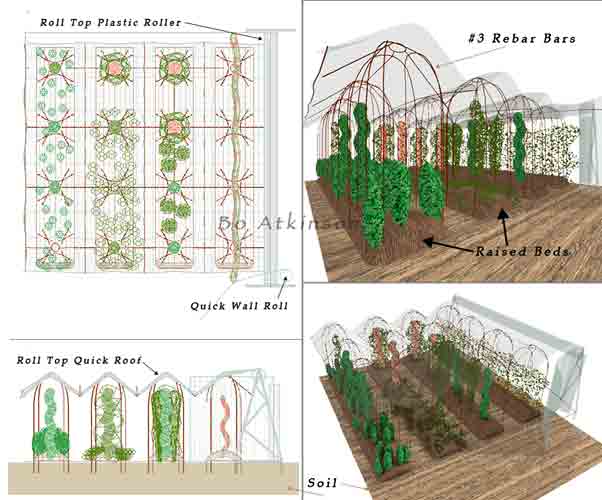
I meditated on the design over time. I did buy building materials like rebar in the boom years, which provides resources for these lower employment years. My region, Maine USA, has long periods of cold weather, with snow. I look for ways to extend growing seasons and harmonize this into daily work-chore patterns. -- It provides reasonable winter exercise, for those who do not like gyms or sterile exercise machines-- Even as a poor man's exercise, productive and useful exercise in the cold winter. 'Uninsulated' and 'unheated' green houses have proved worthwhile, especially in hard economic times. Low employment leaves time forall of this.
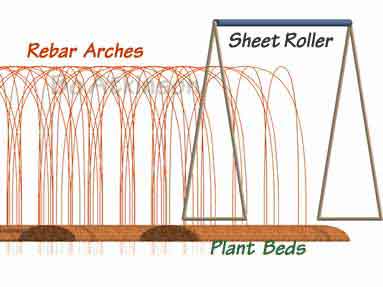
These original schematic diagrams revealed that a 20ft sheet of plastic might quickly roll out and back in. Yet it one doesn't need rollers which are challenging at this scale, (for single handed construction on low budgets). Cold frames speed up spring-soil-warming and warmer work conditions. Covers will protect against early and late frost. It could allow wanted full sun at times. It could provide for simplified opening and closing. It could allow some protectionduring bad seasons.

Design phase revealed 500 lbs of rebar investment might do the job. Plan ahead, invest in practical materials. My garden has sufficient slope to induce some slight draft for good ventilation, good drainage has been vital.

Here is a separate page on 'container gardening' Also,another page of mine-- Lots of related ideas live on this website...Click here to see my eyelid dome greenhouse experiment. Here are some of my visions for greenhouse-container-gardens. Or perhaps 'indoor-hanging-gardens'. Also, here is our long standing slowly progressing home (gradual research), translucent dome, roof-garden or attic-greenhouse.

May 2010 progress picture above-- The elevated roller is difficult to install from scratch. I'll link another 'how-to' page later (here). Regardless of weather extremes, a roll-top garden cover will "save the day". A blighty-wet summer can be kept dry enough for organic stamina against crop loss.

My 09 kale was not even half as good as in better years, but it has been worth the low cost investment in steel and plastic. At least it made it through the winter, ready for early spring food. With the economic depression out of control, one can at least focus on better gardening years ahead. Now that the boom years are past. That never stops me from trying. Some more low-cost methods will follow. First off, how does one heat up soil in cold country? Also how can low cost composting become accelerated, during the early part of the growing season.
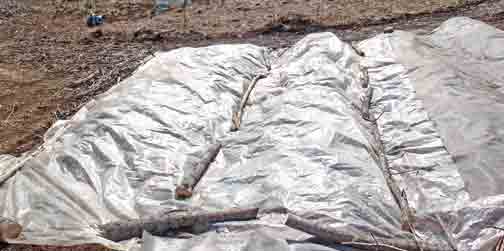
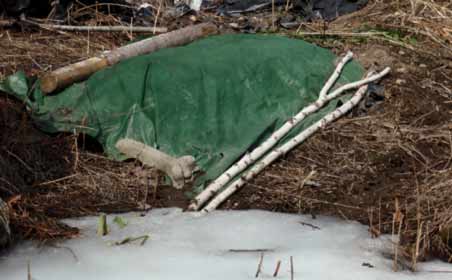
Above are shown easy ways to temporarily cover the ground in very-early spring. By late April, some ground - warmth can be forced downwards. One can simply re-uses the "old greenhouse sheets" or old plastic sheets. This greatly helps outdoor germination. It also fast-forwards the weed seeds, bugs, and green-compost action. This allows one to manage these things earlier, for the season ahead. I eventually discovered that roof rubber serves the purpose best. See my composting and bio digester page.
After warmer weather stabilizes, the sheets should be folded up and stored well out of the sun, for use next year or other purposes, still. The sun's UV (ultra violet spectrum portion) is known to deteriorate many common plastics. There are some UV resistant types available, if one hunts them down and pays more for them. One has to rationalize low-cost-living along with cold climate living, to take advantage of these benefits. Gardening and art can be very laborious.Take heart, it can be a healthy life style. Network with people who encourage one another. Make it feel interesting for oneself and for others at the same time. Blog about it!
The centralized world-order is dying, big-box mentalities are proving questionable in many ways. Let all sides of the issue talk. Why should jobs get exported away while public assets are wasted by glib war mongers? American debt skyrockets into oblivion. How will this be paid: with slavery?
Note: These pages are placed in the public domain and are furnished "as is". The author assumes no responsibility for the use or misuse of the concepts in this series. All authorities should be satisfied first, as might be required, by relevant laws, before any building proceeds.
Conceptual artist is repressed?
![]()